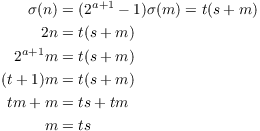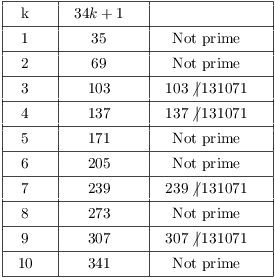Definition. A number ![]() is perfect if
is perfect if ![]() . Equivalently, n is perfect
if it is equal to the sum of its divisors other than itself.
. Equivalently, n is perfect
if it is equal to the sum of its divisors other than itself.
Example. Show that 6 and 28 are perfect.
6 is perfect, because
![]()
28 is perfect, because
![]()
It is not known whether there are any odd perfect numbers, or whether there are infinitely many even perfect numbers. The existence of infinitely many even perfect numbers is related to the existence of infinitely many Mersenne primes by the following result. One implication is in Euclid's Elements, and the other implication is due to Euler.
Theorem. n is an even perfect number if and
only if ![]() , where
, where
![]() is a Mersenne prime.
is a Mersenne prime.
Proof. Here are some preliminaries before I
start the proof. If n is an even integer, write ![]() , where
, where ![]() and
and ![]() . Then
. Then
![]()
I'll use this notation in both parts of the proof.
Suppose that n is perfect, so ![]() .
.
Write
![]()
Note that s is the sum of the divisors of m other than m. Note also
that ![]() , since
, since ![]() .
.
Then

Suppose ![]() . Note that
. Note that ![]() , since
, since ![]() . Then 1 and s are distinct
divisors of m other than m, so
. Then 1 and s are distinct
divisors of m other than m, so ![]() , which
is a contradiction.
, which
is a contradiction.
Thus, ![]() . This implies
. This implies ![]() , so m is prime.
, so m is prime.
Moreover, I get ![]() .
.
It follows that ![]() ,
where
,
where ![]() is prime.
is prime.
On the other hand, suppose ![]() , where
, where ![]() is a Mersenne prime. Then
is a Mersenne prime. Then
![]()
Therefore, n is an even perfect number.![]()
Example. What perfect number corresponds to
the Mersenne prime ![]() ?
?
![]()
I now know that finding even perfect numbers is equivalent to finding
Mersenne primes --- primes of the form ![]() . I showed earlier that
. I showed earlier that ![]() is prime implies that n is prime.
So to look for Mersenne primes, I only need to look at
is prime implies that n is prime.
So to look for Mersenne primes, I only need to look at ![]() for n prime. Next, I'll derive a
result which simplifies checking that
for n prime. Next, I'll derive a
result which simplifies checking that ![]() is prime. First, here's an amusing
lemma.
is prime. First, here's an amusing
lemma.
Lemma. ![]() .
.
Proof. Assume without loss of generality that
![]() . The greatest common divisor of
two numbers doesn't change if I subtract the smaller from the larger,
so
. The greatest common divisor of
two numbers doesn't change if I subtract the smaller from the larger,
so
![]()
Since ![]() is odd, it has no factors in
common with the
is odd, it has no factors in
common with the ![]() in the first term. So
in the first term. So
![]()
Now I see that the "![]() " in each slot is just
along for the ride: All the action is taking place in the exponents.
And what is happening is that the subtraction algorithm for computing
greatest common divisors is operating in the exponents! --- the
original pair a, b, was replaced by
" in each slot is just
along for the ride: All the action is taking place in the exponents.
And what is happening is that the subtraction algorithm for computing
greatest common divisors is operating in the exponents! --- the
original pair a, b, was replaced by ![]() , b.
, b.
It follows that the exponents will "converge" to ![]() , because this is what the
subtraction algorithm does. And when the algorithm terminates, I'll
have
, because this is what the
subtraction algorithm does. And when the algorithm terminates, I'll
have ![]() , proving the result.
, proving the result.![]()
Example. Compute ![]() .
.
![]() , so
, so
![]()
This is surely not obvious, especially when you consider that ![]() and
and ![]() !
!![]()
Theorem. Let p be an odd prime. Every factor
of ![]() has the form
has the form ![]() for some
for some ![]() .
.
Proof. It suffices to prove that the result
holds for prime factors of ![]() . For
. For
![]()
so products of numbers of the form ![]() also have that form.
also have that form.
Suppose then that q is a prime factor of ![]() . Fermat's theorem says
. Fermat's theorem says ![]() . The preceding lemma
implies that
. The preceding lemma
implies that
![]()
Now ![]() and
and ![]() implies
implies ![]() . In particular,
. In particular,
![]() ,
since it's divisible by the prime q. This in turn implies that
,
since it's divisible by the prime q. This in turn implies that ![]() . Now p is prime, so this is only
possible if
. Now p is prime, so this is only
possible if ![]() . In
particular,
. In
particular, ![]() .
.
Write ![]() , so
, so ![]() . q is odd, so
. q is odd, so ![]() is even, and
is even, and ![]() is even. Since p is odd, t must be even:
is even. Since p is odd, t must be even:
![]() for some k. Then
for some k. Then ![]() , which is what I wanted to
show.
, which is what I wanted to
show.![]()
Example. Use the ![]() criterion to determine whether
criterion to determine whether
![]() is prime.
is prime.
![]() . If
. If ![]() has a proper
prime factor, it must have one less than 362, and the prime factor
must have the form
has a proper
prime factor, it must have one less than 362, and the prime factor
must have the form ![]() . So I need to check
the primes less than 362 to see if they divide 131071.
. So I need to check
the primes less than 362 to see if they divide 131071.

Therefore, ![]() is prime.
is prime.![]()
The ![]() known Mersenne
prime was discovered in 2018. It is
known Mersenne
prime was discovered in 2018. It is ![]() and was
found using software developed by the Great Internet Mersenne Prime
Search https://www.mersenne.org.
and was
found using software developed by the Great Internet Mersenne Prime
Search https://www.mersenne.org.
Copyright 2019 by Bruce Ikenaga